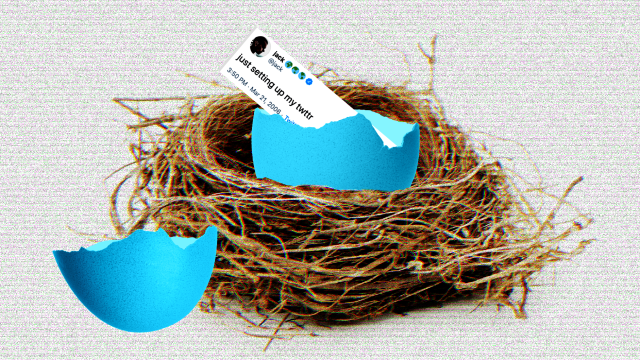The first tweet was sent on March 21, 2006 when cofounder and current CEO Jack Dorsey tweeted, “just setting up my twttr.” Twitter had fewer vowels when it launched, which was the trend at the time with services like Tumblr and Flickr. In just a few years it would become a massive online service.
But what did people think of Twitter when it first launched?
The first review of the service put out by Techcrunch was largely positive, emphasising the early SMS-based nature of the service. Twitter users would text a number to send a tweet, which made its character limit of 140 character not something that was simply arbitrary. That’s all that the system could hold.
From Techcrunch on July 15, 2006:
People are using it to send messages like “Cleaning my apartment” and “Hungry”. You can also add friends via text message, nudge friends, etc. It really a social network around text messaging – and is very similar to another service called Dodgeball.
[…]
There is also a privacy issue with Twttr. Every user has a public page that shows all of their messages. Messages from that person’s extended network are also public. I imagine most users are not going to want to have all of their Twttr messages published on a public website.
If this was a new startup, a one or two person shop, I’d give it a thumbs up for innovation and good execution on a simple but viral idea.
Slate, which often spent the 2000s as the go-to place for professional contrarianism, published an article on November 27, 2006 that ridiculed the common idea of what Twitter could be:
For the ultimate in solipsism, check out Twitter.com, a site where—once you register—you can answer the question, “What are you doing?” At 7:47 a.m. on Monday, for example, Lynda was going to get a glass of cold water.
This raises more questions than it answers. Did she get it? Was it cold enough? Tragically, we’ll never know until someone starts a site about what you were doing before what you’re doing now. Or possibly an interactive site about what you are going to do next after you finish doing what you’re doing now. There could be multiple options. People could vote. Hey, someone call Google. We’re rich!
A Los Angeles Times story was syndicated to newspapers across the country in late December of 2006, explaining that Twitter could very well be the future of the internet, even if it seemed a bit banal:
Twitter works by hypercharging social networks such as those on MySpace or Friendster. A new Twitter user creates a very basic profile and then creates a mini-network by linking to his or her friends, family, acquaintances and pretty faces found through browsing the site. Then, whenever the mood strikes, the user logs in to Twitter.com (or sends it a note via text or instant messenger), answering the “What’re you doing” question in 150 [sic] characters or fewer. Once you chime in with your latest activity or pondering, your message is radiated out to all the members of your circle, who can check in at their page to see what their friends are up to, or better still, receive flashing updates on their cell phones or instant messengers whenever a friend checks in.
The result, according to Jack Dorsey, the force behind Twitter, “brings you closer to everyone, because you know what everyone is doing, things you would never imagine.”
On a typical Sunday evening, a glance at Twitter’s public page, where its users’ collective messages are posted, does reveal a cross section of what might be a moment in the life of the Information Generation.
Twitter saw explosive growth in 2008, and by the summer of that year people were already poking fun at the Twitter hype.
One guy named Ben Walker even wrote a song for YouTube, appropriately titled “The Twitter Song” with lyrics like:
You’re no one if you’re not on Twitter
And if you’re not there already you’ve missed it
If you haven’t been bookmarked, retweeted and blogged, you might as well not have existed
You might as well not have existed
Walker got particularly excited when actress Demi Moore tweeted his video
Hilarious! RT @Ammidon: Just for fun…”You’re No One If You’re Not On Twitter”… ♫ http://blip.fm/~4bcwc
— Demi Moore (@justdemi) April 14, 2009
By early 2009, Twitter was popular enough that local TV news stations started doing explainers on the service, like this one from KMBC 9 in Kansas City.
If nothing else, the videos from 2009 give you a sense of just how different the user interface of Twitter looked a decade ago.
Twitter would go on to play an integral role in world politics, starting perhaps with the so-called Arab Spring of 2010-2011, where millions took to the streets in the Middle East and North Africa to demand political reforms. Social media platforms like Twitter were credited with allowing to people organise protests and governments like Egypt did everything they could to censor Twitter.
[referenced url=” thumb=” title=” excerpt=”]
By 2016, Twitter would be instrumental in the election of Donald Trump, who became president thanks in no small part to his racist, misogynist rhetoric on the platform.
And while there are plenty of things wrong with Twitter, it has also been an invaluable resource for people looking for information during our latest crisis, providing information like how to 3D-print ventilators, how to hack existing ventilators to serve more people, and just generally spreading useful information about how the disease is spreading around the world.
[referenced url=” thumb=” title=” excerpt=”]
Twitter stills has a few kinks to work out. And though I probably have Twitter to thank for things like my job, it can still be a place of more noise than signal. And then, of course, there are the Nazis. One day, hopefully they’ll get around to ousting the Nazis. We can dream in these trying times, can’t we?
